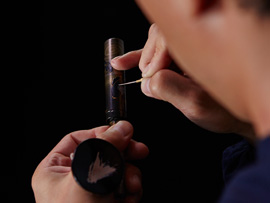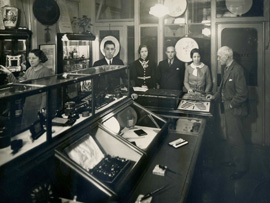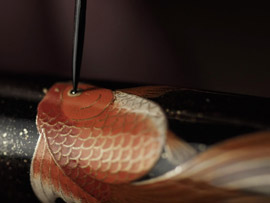

TOP / About Namiki / History of the birth of Namiki
A “challenge to the world” was the driving force which lead to the birth of Maki-e fountain pens.
Since our inception in 1925, as the top brand of Maki-e fountain pens conveying Japanese traditional culture,
we have followed a path earning praise from around the world up until today.

Around 90 years ago, it was normal practice to use a material called “ebonite”, a combination of sulphur and rubber, for the body of fountain pens. However, although ebonite showed tolerance toward ink, it had the shortcoming of changing colour and losing its shine over time. It was where Namiki Co., Ltd. (now PILOT Corporation) formed a specialist development team to overcome this problem.
It was “lacquer” that caught their eyes. Using lacquer, a superior coating which Japan boasts to the world, they devised a method called “lacquered ebonite” which creates an attractive body which was tolerant to deterioration. With the original goal being achieved with this, there were further calls saying, “If we are going to use lacquer, why don’t we try painting designs using the lacquer work technique Maki-e on the fountain pens?”
For luxury fountain pens in Western countries at the time, decorating the metal bodies with elaborate metal-carving techniques and designs was normal. By combining strength and beauty, it was thought that by making fountain pens with Maki-e, a culture associated with Japan, they could compete on even-footing throughout the world.


Maki-e is a traditional craft where the delicate process of lacquering is repeated over and over. It goes without saying that it cannot be imitated in a short time. There, from an introduction by a pioneer in the lacquerwork world, Shisui Rokkaku, pupil and later to become living national treasure, Maki-e artist Gonroku Matsuda, was invited, and under instruction from the pair, the Maki-e fountain pen was completed.


Founders Ryosuke Namiki and Masao Wada took a few dozen of their just-completed Maki-e fountain pens, and embarked on a voyage to Western countries to develop their market. The same year, in 1925, they immediately received an order from a major firm in London, and in 1926, “the PILOT Office” was opened on Bishopsgate Street in London. In 1930, a contract was signed with Alfred Dunhill. The pens were sold large-scale in major cities such as London, Paris and New York as “Dunhill-Namiki Fountain Pen”, and Namiki Co., Ltd. had gained a foothold in playing a major role in the world.


Centered around Gonroku Matsuda, the artisan group “Kokkokai” was formed in order to research, develop and improve the quality of Maki-e fountain pens. The name “Kokkokai” was derived from a quote by Namiki founder Ryosuke Namiki, “In the way Sumo is Japan’s national sport, Maki-e is the nation’s light.”
The following is the declarative statement by one of the founders, Ryosuke Namiki, to the members of “Kokkokai” on its inauguration in August 1931. In the bright and cheerful statement he explains the origins of the name “Kokkokai”, showed “passion and pride” to high quality in his words of encouragement to the members, and reflects on being a leader for other companies in “sales strategies in overseas markets”, an extremely rare thing for those days.
August 1931
Ryosuke Namiki
As something for Japan to boast, shining the nation’s light (Kokko) overseas, we have the Japanese spirit and Maki-e.
The Japanese spirit has become famous internationally, but Maki-e is about to start.
Now, with the belief that those involved in Maki-e will join together and want to expand the Maki-e technique worldwide,
having hopes pinned on a certain group is a great thing indeed.
If we are going to do it, we have to do it seriously!.....
If we have a small idea, we had better not do it.
If we are going to do it, if we are going to do it with the small ideas we have had so far,
as true artisans representing our country, we have to make a great efforts toward making Kokko successful in overseas,
otherwise the group’s name will also be associated as being narrow-minded.
After thinking it over, I believe we should go with the name “Kokkokai”.
It goes without saying that, in the way sumo is Japan’s national sport, Maki-e is the nation’s light.
When you think about it, this name is extremely grand, almost too grand.
As a name attached to a small group, I thought the name was too imposing,
but, as a great ambition, to aspire for true solidarity in shining our nation’s light overseas,
a name of this size is necessary.
Only one.
I will always be hoping that you always keep this name in mind and carry a lot of pride,
and dedicate yourselves as not to sully the name.
I have high hopes
Namiki Maki-e fountain pens are the ultimate in beauty, techniques and spirit inherited from our predecessors, and also the roots of PILOT. Over many years to the present day, as the top brand in Maki-e fountain pens conveying Japanese traditional culture, we are highly regarded around the world.
U.S.A.『PEN WORLD』
2012 PEN WORLD Reader’s Choice Award Nominations Best Maki-e |
|
| 2011 | Setsugekka(PEN WORLD Reader’s Choice Award Nominations Best Maki-e) |
|---|---|
| 2012 | Golden Rose(PEN WORLD Reader’s Choice Award Nominations Best Maki-e) |
| Noshi Bundle(PEN WORLD Reader’s Choice Award Nominations Best Maki-e) | |
| 2013 | Yabusame(PEN WORLD Reader’s Choice Award Nominations Best Maki-e) |
| Kylin(PEN WORLD Reader’s Choice Award Nominations Best Maki-e) | |
France『Stylographe』
2012 Trophee de l'excellence
2014 Le Grand Trophée du Stylographe |
|
| 2012 | Parrot with Peach(Trophée de l'excellence) |
| 2014 | 4 Yukari Chinkin(Pine Tree・Crane・Cherry Blossoms・Silver Grass) (Le Grand Trophée du Stylographe) |